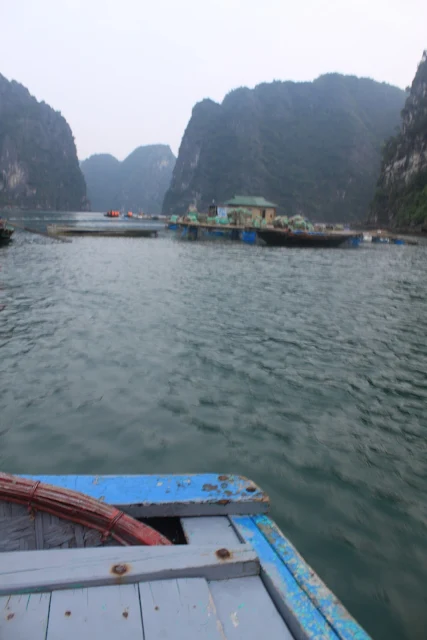With around three thousand limestone monolithic isles, Ha Long Bay has a charm and scenic splendour of its own. Nestled below the southern Chinese coasts and Hainan Island, it is a maritime ecosystem that has caves, grottoes and hidden lakes in islands; displays very few beaches; offers various fascinating shapes in the landscape akin to elephants, cockerels and more; harbours wildlife like monkeys, lizards, bantam birds and antelopes on limited landed areas; and holds a special place in Vietnamese legend relating to benevolent dragons. It is also a declared UNESCO world heritage site. Photo above shows our personalised boat paddler taking Matt and me around the bay.
A community of fisher villagers call this place home, making their livelihood on aquaculture and the natural resource pools of mollusks and fishes that live in the bay. Residents live a transient yet permanent life style, with houses literally floating on the water, or on boats that are moored above calm and placid waters on the evening we visited. I did wonder what does it feel and look like on a stormy night. On a cloudy and hazy twilight in November, going round a particular village, we were paddled by strong young women on boats that sat a maximum of four persons - we observed it was a like a self-contained suburb, with the goings-on of human life, family activities, goods transported and food cooking from kitchens. Self- managed generators are used for night lighting. The thought that crossed my mind was also, did they have strong Internet wireless, effective sanitation systems, herbal gardens and television broadcasts? The very things that I have taken for granted.
The boats look Chinese in design but carry the Vietnam flag (picture above) in a region of the South China Sea that has witnessed conflict between the national neighbours. Are there unknown huge reserves of other natural resources in these waters? I noticed an absence of bird life on my visit. In times of war, these isles must have been a natural beacon for those trying to escape military encounters.
Research has shown that these places have been occupied as far back as eighteen thousand years ago, although the contemporary villages we saw dates back from the beginning of the 19th century. How do such villagers handle the challenges of the 21st century - acting to mitigate pollution, treating industrial and domestic waste, managing the arrival of more tourists and sustaining a livelihood? There are around 1700 individuals living here, mostly in tight knit families. Below, Mr Kien, the leader of our tour, smiles to the camera as he sits with residents on a floating pontoon.
Sunset on Ha Long Bay (above) brought out the best of artistic and natural landscapes, one that evoked the heritage styles of Chinese and Vietnamese paintings and poetry. Below, tourists spewing out from various cruise ships make a bee line on small flat wooden boats to authentic villages which exist not for tours, but for themselves, for now. However, economics have encouraged the emergence of vendor boats with rowers, usually women, who offer refreshments and local souvenirs to passengers on cruise ships that park over night or sail by for day excursions.
Mangrove swamps and sea grass clumps dominate the interface between land and water in Ha Long.
Logically there may be no form of land ownership for the bay's four main villages. Residents, including youngsters and children, are expert at casting nets, navigating boats and processing sea produce. Visiting Ha Long Bay, I am reminded to compare with the Andaman Sea near Phuket in Thailand - there, limestone drip creation processes and geological upheavals over thousands of years have also created a similar scenery over the waters, articulated the geographical concepts of stalagmites and stalactites and attracted both foreign and domestic tourists over so many years.
The romance of the place for me began with a specific James Bond movie, The Man with The Golden Gun. I recall a film episode where Bond himself flew in a plane over what was supposed to be Ha Long Bay, but in reality it was substituted with footage of the Andaman Sea near Phuket. Norwegians can perhaps share familiarities with Lofeten but in a different climate.














No comments:
Post a Comment